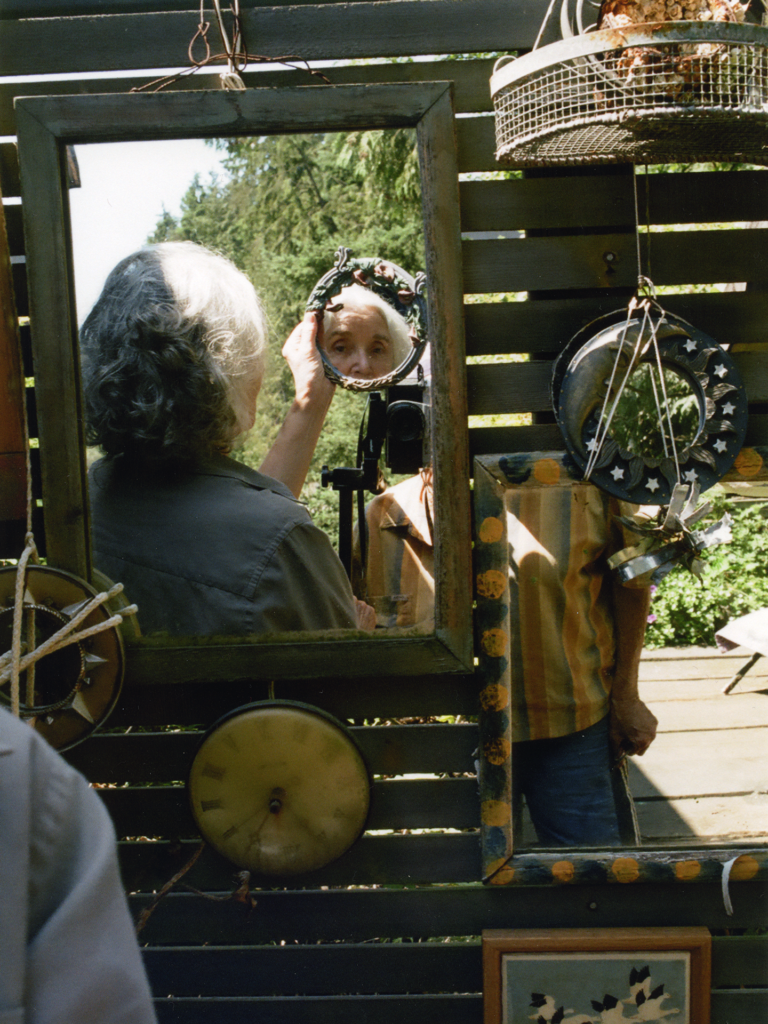Carole Itter

Carole Itter, interdisciplinary artist, writer, performer and filmmaker began her fine art studies at the University of British Columbia (1958, 1963), and continued at the Vancouver School of Art (1959 – 1963) (now Emily Carr University), and at L’Accademia di Belle Arti in Rome (1964). Since 1966, she has been creating works for performance, exhibition, and film.
She joined her partner, musician, writer, and visual artist, the late Al Neil at the Blue Cabin in Dollarton in the late 1970s. It was the start of a residency that would span more than thirty-five years. Though the cabin became a place of inspiration and art production for her, Itter still maintained her residence in the Vancouver neighbourhood of Strathcona, where she has lived since the early 1970s.
Itter’s works are influenced by the Northwest Coast, and respond to social and political issues drawing on the lived experience of people and place.[1] Her solo exhibition Where the Streets are Paved in Gold: A Tribute to a Canadian Immigrant Neighbourhood featured a floor installation inspired by early immigrants in her community and their belief that Canada was a place “where the streets are paved with gold”. The work is partly made up of discarded objects that Itter collected in her neighbourhood, which she then painted and gilded to form a 29-foot golden ‘street’ spilling forth from the base of an antique organ. Vancouver artist Luke Blackstone converted the organ into a kinetic sound machine, and Al Neil played it in a performance of O Canada at the exhibition opening. A recording of Neil’s performance was later integrated into the floor assemblage through a speaker system, and it became part of the permanent work.

Where the Streets are Paved in Gold has been presented in solo exhibitions at the Vancouver Art Gallery (1991) and at Open Space in Victoria (1994), and in a group exhibition at the Musée de la Civilisation in Québec City (2005). Itter’s solo exhibitions include Vancouver Art Gallery, grunt gallery, Western Front, and Or Gallery, and her work was included in WACK! Art and the Feminist Revolution at the Vancouver Art Gallery. During her residency time at the Blue Cabin in Dollarton, Itter and Neil’s assemblage works could be found sitting near the water and installed around the site. From 1979 through 1985, Itter provided all photo collage and graphic projections for Neil’s multimedia performances.
Itter has written and published short stories and prose pieces. With Daphne Marlatt, she compiled and edited an archive of oral history about Vancouver’s East End as part of the Sound Heritage Series for the British Columbia Provincial Archives. This work was first published in 1979, with a second printing in 1980, and was republished in 2011 by Harbour Publishing. Itter’s work is included in the collections of the Canada Council Art Bank, the Vancouver Public Library, and the Vancouver Art Gallery, SFU Galleries, Morris and Helen Belkin Art Gallery, Surrey Art Gallery, and Nanaimo Art Gallery. She is the recipient of the VIVA Award (1989), and the 2017 Audain Prize for Lifetime Achievement in the Visual Arts.[2]
More here: http://www.vancouverartinthesixties.com/people/133
[1] Adapted from Audain Prize biography, 2017
[2] Biographical notes: Carole Itter in conversation with Marlene Madison, May 2019.